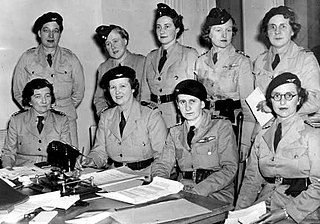Mary Bell (aviator)
Mary became leader of forty or so members of the Women's National Emergency Legion Air Wing who had volunteered to assist with aircraft maintenance during times of war.
Determining that their objectives would not be met in their existing organisation, on 17 July they formed a new volunteer paramilitary group, the Women's Air Training Corps (WATC), and elected Bell its commander.
[10] The WATC was one of several women's voluntary organisations whose members were keen to support the military, arguing that their personnel provided a ready-made pool of skilled staff for auxiliary services, saving the government time and money training unskilled labour.
[11] Australia having declared war on Germany on 3 September 1939, the RAAF Air Board met in November to discuss Bell's letter, but postponed taking action.
Mary recommended forming the new service under the Air Force Act to permit women to enlist for the duration of the war under conditions similar to RAAF members, rather than enrolling on a short-term contractual basis, a radical idea at the time that would not be put in place until 1943.
She also suggested a volunteer reserve or citizen force to augment the enlisted women, effectively the existing WATC, though this was seen as placing too much emphasis on her personal command.
Burnett, an RAF member who appreciated how the WAAF proved its worth during the Battle of Britain, championed its establishment as the Women's Auxiliary Australian Air Force (WAAAF).
[16] Formally established on 25 March, the WAAAF was the first uniformed women's branch of an armed service in Australia, predating similar organisations in the Army and Navy.
[18] Notwithstanding her aviation experience and familiarity with the RAAF, he considered Bell to be "tangled up with the WATC", where she "waved the flag and obtained a great deal of publicity for herself".
[19] Bell chose to resign on learning of Stevenson's appointment, rather than stay on and report to someone from outside the service fraternity; she later rejoined at Wrigley's request, but stipulated that she would accept no promotion higher than flight officer.
[18] By the end of the war 27,000 women had served in the WAAAF, at one stage comprising over thirty-one per cent of ground staff and filling sixty-one trades, all previously occupied by men.
Survived by her daughter, Bell died in Ulverstone, Tasmania, on 6 February 1979, and was buried beside her husband, who predeceased her in 1973, at Mersey Vale Memorial Park cemetery in Spreyton.

